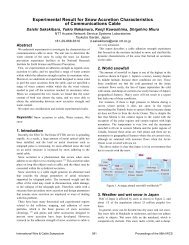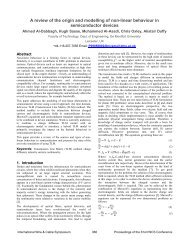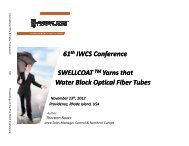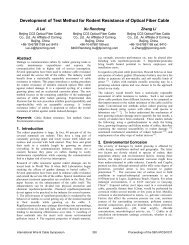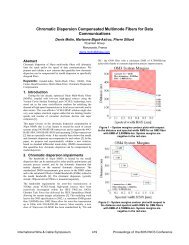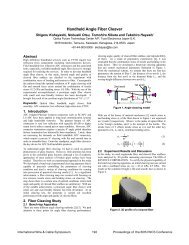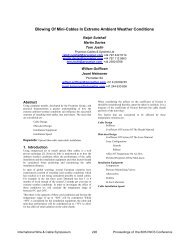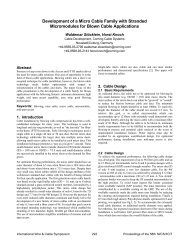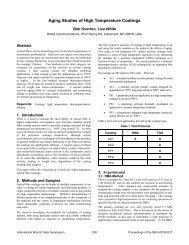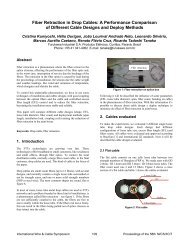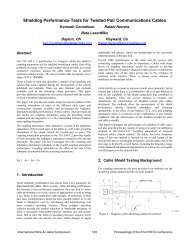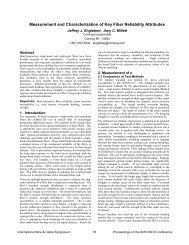Special Cables and the Challenge to Meet NFPA 79® Requirements
Special Cables and the Challenge to Meet NFPA 79® Requirements
Special Cables and the Challenge to Meet NFPA 79® Requirements
Create successful ePaper yourself
Turn your PDF publications into a flip-book with our unique Google optimized e-Paper software.
<strong>Special</strong> <strong>Cables</strong> <strong>and</strong> <strong>the</strong> <strong>Challenge</strong> <strong>to</strong> <strong>Meet</strong> <strong>NFPA</strong> 79® <strong>Requirements</strong>Stefan M. GrunwaldProduct ManagerLutze Inc.Charlotte, NC+1-704-248-5310sgrunwald@lutze.comJörg BörProduct ManagerFriedrich Lütze GmbH & Co KGWeinstadt, Germany+49-7151-6053-274joerg.boer@luetze.deAbstract<strong>NFPA</strong> 79 Electrical St<strong>and</strong>ard for Industrial Machinery 2007Edition is currently <strong>the</strong> electrical st<strong>and</strong>ard for industrial machineryin <strong>the</strong> USA. A number of significant updates were implemented in<strong>the</strong> 2007 edition. The <strong>NFPA</strong> 79® is a st<strong>and</strong>ard published by <strong>the</strong>National Fire Protection Agency (<strong>NFPA</strong>), <strong>the</strong> same agency thatpublishes <strong>the</strong> National Electric Code (a.k.a. NEC® or <strong>NFPA</strong> 70®).The <strong>NFPA</strong> 79 has special provisions addressing safe wiringpractices for industrial machinery such as machine <strong>to</strong>ols. Chapter 12of <strong>the</strong> <strong>NFPA</strong> 79 addresses cables <strong>and</strong> cords for use with industrialmachinery. Article 12.2.7.3 enforces a significant change as itspecifically prohibits <strong>the</strong> use of AWM (Appliance Wiring Material)style cable “unless it is part of a listed assembly”.Permitted under <strong>NFPA</strong> 79 2007 regulations are UL listed typecables if suitable for <strong>the</strong> intended use <strong>and</strong> Machine Tool Wire(MTW). The common practice of freely combining AWMinsulation styles with jacket styles is not permitted for UL listedcables; <strong>the</strong>refore, <strong>the</strong> level of cus<strong>to</strong>mization <strong>to</strong> meet applicationrequirements may be limited.Keywords: <strong>NFPA</strong> 79; <strong>Special</strong> Application; AWM; IndustrialMachinery; St<strong>and</strong>ard; Industry St<strong>and</strong>ard; cus<strong>to</strong>m cable; machine<strong>to</strong>ols; oil resistance; abrasion resistance; UV resistance; Industrial;flexing cable; continuous flexing; super flexible; high flexible; NEC1. Introduction1.1 St<strong>and</strong>ardsA st<strong>and</strong>ard can be defined as “a set of rules” that allows <strong>to</strong> measurequality <strong>and</strong> offers a reference for comparison. These rules describe aproduct, procedure or process. A st<strong>and</strong>ard may also provideinstructions on how <strong>to</strong> do a task safely <strong>and</strong> consistently. Everycountry that is participating in <strong>the</strong> global economy has some sort ofst<strong>and</strong>ard describing proper procedures in order <strong>to</strong> ensure safety for<strong>the</strong> opera<strong>to</strong>r <strong>and</strong> protection for <strong>the</strong> equipment. That makes ast<strong>and</strong>ard more than just common practice; a st<strong>and</strong>ard is an officialset of written <strong>and</strong> published rules which are accessible <strong>to</strong> <strong>the</strong> public.St<strong>and</strong>ards are not considered m<strong>and</strong>a<strong>to</strong>ry by law directly, until <strong>the</strong>ybecome a code or are adopted in<strong>to</strong> law by authorities, such as a localor state government.St<strong>and</strong>ards are evolving with <strong>the</strong> engineering advancement that isbeing made every day. In <strong>to</strong>day’s global economy it is veryimportant <strong>to</strong> have st<strong>and</strong>ards that not only protect <strong>the</strong> safety interestwithin <strong>the</strong> country <strong>to</strong> which <strong>the</strong> st<strong>and</strong>ard applies <strong>to</strong>, but also <strong>to</strong>ensure <strong>the</strong> equipment can safely be used in o<strong>the</strong>r countries as well.Every country or community, however, has its own rules on how ast<strong>and</strong>ard is being implemented <strong>and</strong> how it is being observed. Thishas lead <strong>to</strong> an important process in <strong>the</strong> development of st<strong>and</strong>ardscalled ‘harmonization”. An example of harmonization would be if ast<strong>and</strong>ard’s committee writing a st<strong>and</strong>ard in <strong>the</strong> USA is considering<strong>the</strong> contents of a similar st<strong>and</strong>ard written in Europe <strong>to</strong> ensure that<strong>the</strong> basic message is <strong>the</strong> same.1.2 Industrial Machinery <strong>and</strong> its his<strong>to</strong>ryIndustrial machines are devices or groups of devices working in acoordinated manner <strong>to</strong> process material. Industrial machinery hasbeen used <strong>to</strong> perform work for centuries <strong>and</strong> while <strong>the</strong> firstmachines were driven by human or animal power, it wasn’t for longthat machines were powered by o<strong>the</strong>r sources, such as hydro orwind power. Since <strong>the</strong> Industrial Revolution machines have becomemore complex <strong>and</strong> versatile; <strong>and</strong> since <strong>the</strong> electrification ofmachines <strong>the</strong> term “machine <strong>to</strong>ol” now associates electrical powermeans <strong>to</strong> drive it. Along with <strong>the</strong> electrification of machines a newera of devices was born. Mo<strong>to</strong>rs, gears <strong>and</strong> transmissions offeredmore versatility <strong>and</strong> power output. The more complex <strong>the</strong>semachines became, <strong>the</strong> more parties got involved in specializing in<strong>the</strong> development of certain components or sub assemblies. In order<strong>to</strong> make <strong>the</strong>se components or sub assemblies work <strong>to</strong>ge<strong>the</strong>r,st<strong>and</strong>ards had <strong>to</strong> be introduced. Some st<strong>and</strong>ards aimed <strong>to</strong> make <strong>the</strong>machines <strong>and</strong> subassemblies compatible with each o<strong>the</strong>r, whileo<strong>the</strong>rs were introduced <strong>to</strong> improve <strong>the</strong> safety for opera<strong>to</strong>rs <strong>and</strong>equipment. Different countries followed different philosophies, <strong>and</strong>as a result <strong>the</strong> st<strong>and</strong>ards for industrial machines could differ in <strong>the</strong>industrialized countries.Industrial machinery <strong>and</strong> its equipment can vary greatly in form <strong>and</strong>function. State of <strong>the</strong> art machinery comes in sizes as small as ah<strong>and</strong>held devices or large enough <strong>to</strong> fill several football fields.Some machines may perform relatively simple tasks while o<strong>the</strong>rshave complex operations following a timed program precisely <strong>and</strong>repeatedly. The speed of motion <strong>and</strong> <strong>the</strong> level of intelligence canvary greatly as well. Machine <strong>to</strong>ols can perform <strong>to</strong>ol exchangesfaster than ever before <strong>and</strong> linear mo<strong>to</strong>r technology has greatlyimproved <strong>the</strong> traversing speed of modern machines. Theintroduction of field bus <strong>and</strong> network systems in<strong>to</strong> <strong>the</strong> world ofindustrial machines applies more <strong>and</strong> more intelligence <strong>to</strong> <strong>the</strong>devices in <strong>the</strong> field level.Putting that level of intelligence in<strong>to</strong> <strong>the</strong> field level of industrialmachines means that digital input <strong>and</strong> output signals are beingcomputed <strong>and</strong> transmitted via copper or fiber cable in harshindustrial environments. For example, <strong>the</strong> introduction of industrialE<strong>the</strong>rnet required cables <strong>and</strong> connec<strong>to</strong>rs <strong>to</strong> meet <strong>the</strong> requirements of<strong>the</strong> field level <strong>and</strong> started <strong>the</strong> development of industrial E<strong>the</strong>rnetcable. <strong>Cables</strong> for industrial machinery must be designed <strong>to</strong>withst<strong>and</strong> <strong>the</strong> harsh environments in which <strong>the</strong>y are used. Theserequirements can vary greatly depending on <strong>the</strong> environment <strong>the</strong>International Wire & Cable Symposium 163 Proceedings of <strong>the</strong> 58th IWCS/IICIT
machine will operate in. Some of <strong>the</strong> requirements in suchenvironments may be:• Abrasion resistance• Oil resistance (especially in metal cutting devices)• UV resistance• Flexibility for easy routing <strong>and</strong> bending• Flexibility <strong>to</strong> perform continuous flexing operation• High temperature resistance• High shielding capabilities in EMC applications for noisereduction• Reliability (especially for data cables)• Flame retardancy <strong>and</strong> burning behaviorAll <strong>the</strong>se requirements <strong>and</strong> more have <strong>to</strong> be considered when a cableis designed for industrial applications. In addition <strong>to</strong> meeting all<strong>the</strong>se requirements, a cable also needs <strong>to</strong> be compliant <strong>to</strong>“St<strong>and</strong>ards” <strong>and</strong> “Codes” <strong>to</strong> ensure <strong>the</strong> required safety.1.3 <strong>Special</strong> ApplicationNei<strong>the</strong>r <strong>the</strong> NEC Code nor <strong>the</strong> <strong>NFPA</strong> 79 St<strong>and</strong>ard includes “specialapplication” as part of <strong>the</strong>ir definition. But if machines becomeevermore complex <strong>and</strong> cus<strong>to</strong>mized, <strong>the</strong> level of what is considered“special application” must exist.The <strong>NFPA</strong> 79 however does define “special cable” as a cableintended for specific limited purposes. Following that notion, aspecial application would be an application that performs a task thatrequires a cable not available as a st<strong>and</strong>ard product <strong>and</strong> is designed<strong>to</strong> meet <strong>the</strong> specific requirements of <strong>the</strong> application. Such cablecould have design properties <strong>to</strong> meet mechanical, temperature orsimply termination requirements. Examples for such applicationscould be:• Constant flexing cable for linear motion requirements• High temperature cable• Composite cableIn each case <strong>the</strong> cable would fall in<strong>to</strong> <strong>the</strong> definition of special cableperforming a task limited <strong>to</strong> a specific purpose in <strong>the</strong> application.2. <strong>NFPA</strong> 79 2007 edition2.1 IntentionThe <strong>NFPA</strong> 79 code is named: “Electrical St<strong>and</strong>ard for IndustrialMachinery 2007 Edition”. As such it covers specifications forelectrically safe machinery, protection of people <strong>and</strong> equipment,machine control design, installation of equipment <strong>and</strong> wiringmethods <strong>and</strong> <strong>the</strong> proper marking <strong>and</strong> documentation. The <strong>NFPA</strong> 79st<strong>and</strong>ard initially started in 1941 as a subcommittee which wouldinvestigate exceptions <strong>and</strong> add-ons <strong>to</strong> <strong>the</strong> National Electric Code forindustrial machinery. Today <strong>the</strong> <strong>NFPA</strong> 79 has developed in<strong>to</strong> <strong>the</strong>st<strong>and</strong>ard for electrical industrial machinery <strong>and</strong> has beenharmonized <strong>to</strong> some extend with international st<strong>and</strong>ards such as IEC204-1 (EN60204-1).“Guard against <strong>the</strong> risks of fire <strong>and</strong> shock. Work with <strong>the</strong>benchmark for industrial machinery safety: <strong>NFPA</strong> 79! Apply <strong>the</strong>new best practices for <strong>the</strong> full spectrum of equipment—from singlemo<strong>to</strong>reddrill presses <strong>to</strong> complex au<strong>to</strong>mated manufacturing systems.Revised based on advanced technologies <strong>and</strong> industry needs, <strong>the</strong>2007 <strong>NFPA</strong> 79: Electrical St<strong>and</strong>ard for Industrial Machineryprovides up-<strong>to</strong>-date design <strong>and</strong> installation provisions for all typesof electrical/electronic machinery.” [1]2.2 Scope of <strong>NFPA</strong> 79 2007 editionThe <strong>NFPA</strong> 79 is intended <strong>to</strong> apply <strong>to</strong> <strong>the</strong> electrical equipmen<strong>to</strong>perating at 600V or less used with a variety of machines. <strong>NFPA</strong> 79begins at <strong>the</strong> point of connection of <strong>the</strong> supply <strong>to</strong> <strong>the</strong> machine.2.3 Applying <strong>NFPA</strong> 79In most cases <strong>the</strong> AHJ (Authority Having Jurisdiction) decideswhe<strong>the</strong>r or not <strong>the</strong> <strong>NFPA</strong> 79 is being applied. The AHJ usually is<strong>the</strong> organization or individual who approves or operates <strong>the</strong>equipment <strong>and</strong> can be <strong>the</strong> owner or opera<strong>to</strong>r of equipment, <strong>the</strong>insurance company or <strong>the</strong> technical inspec<strong>to</strong>r. If <strong>the</strong> <strong>NFPA</strong> 79 hasbeen adopted in<strong>to</strong> law, such as is case in <strong>the</strong> sate of Ohio, <strong>the</strong>st<strong>and</strong>ard becomes m<strong>and</strong>a<strong>to</strong>ry <strong>and</strong> has <strong>to</strong> be applied.2.4 Meaning for CableThe <strong>NFPA</strong> 79 st<strong>and</strong>ard has provisions for cable <strong>and</strong> flexible cord inChapter 12. The st<strong>and</strong>ard describes in detail how cables should beconstructed <strong>to</strong> meet application requirements. The <strong>NFPA</strong> 79differentiates between “cables” <strong>and</strong> “flexible cord” as cord is notconsidered cable for fixed install <strong>and</strong> only permitted as described inNEC 400.7 <strong>and</strong> 400.8.One of <strong>the</strong> changes in <strong>the</strong> 2007 edition of <strong>the</strong> st<strong>and</strong>ard is describedin paragraph 12.2.7.3, which states that <strong>the</strong> use of cable, typeAppliance Wiring Material (AWM), is no longer permitted. As anexception AWM can only be used when it is part of a listedassembly suitable for <strong>the</strong> intended application. Permitted are onlylisted conduc<strong>to</strong>rs <strong>and</strong> cables such as Machine Tool Wire.This change was adopted by <strong>the</strong> committee because AWM isgenerally not evaluated for direct field installation. AWM cables areconsidered a UL recognized component for fac<strong>to</strong>ry installedappliances wired within <strong>the</strong> overall enclosure of appliances orexternal interconnection of appliances.UL AVLV2. Guide Info Appliance Wiring Material - Componentstates: “The devices covered under this category are incomplete incertain constructional features or restricted in performancecapabilities <strong>and</strong> are intended for use as components of completeequipment submitted for investigation ra<strong>the</strong>r than for directseparate installation in <strong>the</strong> field. THE FINAL ACCEPTANCE OFTHE COMPONENT IS DEPENDENT UPON ITSINSTALLATION AND USE IN EQUIPMENT SUBMITTEDTO UNDERWRITERS LABORATORIES INC.” [2]2.5 AWM UL recognized vs. listed cables2.5.1 UL recognizedAppliance Wiring Material is regulated by UL 758 <strong>and</strong> is generallya UL recognized type of cable showing a recognized logo:UL offers a variety of AWM styles which specify how a cable mustbe built e.g.:• Wall thickness of insulation <strong>and</strong> cable jacket,International Wire & Cable Symposium 164 Proceedings of <strong>the</strong> 58th IWCS/IICIT
• Temperature range,• Insulation materials,• Voltage, etcWhat makes AWM unique is <strong>the</strong> combination of styles whichallows designing a cable that meets <strong>the</strong> application requirements.Figure 1. Combination of insulation <strong>and</strong> jacket stylesThe combination of AWM styles function almost like “recipes” <strong>to</strong>meet an application requirement. If <strong>the</strong> application calls for acable with TPE 600V insulation <strong>and</strong> an oil-resistant Polyurethanejacket, it is permissible <strong>to</strong> combine styles provided <strong>the</strong>y meet <strong>the</strong>common requirements for <strong>the</strong> overall assembly. For example, inorder <strong>to</strong> satisfy <strong>the</strong> requirement of 600V, both <strong>the</strong> insulation styleas well as <strong>the</strong> jacket style must be rated for 600V. If <strong>the</strong> insulationstyle is only permitted for use as 300V, <strong>the</strong> whole cable can onlybe marked 300V even though <strong>the</strong> jacket style would permit 600V.2.5.2 UL listed cablesCommon examples of UL listed cables for <strong>the</strong> use with industrialmachinery are MTW, TC, TC-ER, PLTC, ITC, <strong>and</strong> CM. Thesetypes are evaluated in more detail <strong>the</strong>n AWM cables <strong>and</strong> a freecombination of styles is not allowed. The UL “recipes” <strong>to</strong>manufacture <strong>the</strong>se products are much more detailed <strong>and</strong> <strong>the</strong>evaluation requires testing of <strong>the</strong> actual product. UL listed cablesmay carry <strong>the</strong> following UL mark:insulation only allow UL marking per UL AWM <strong>and</strong> do notqualify for any listed cable types.2.6.2 Composite cableA control application may require composite cable that consists ofcomponents of different gage sizes <strong>and</strong> is <strong>to</strong> be terminated in onelarge cus<strong>to</strong>m connec<strong>to</strong>r. AWM offers an easy way <strong>to</strong> build acomposite cable per <strong>the</strong> equipment manufacturer’s specifications<strong>and</strong> apply this cable in<strong>to</strong> <strong>the</strong> machine control design. In thisprocess each component would have been built per proper AWMprocedure <strong>and</strong> <strong>the</strong> composite cable would be jacketed inaccordance with a matching jacket style. Manufacturing onecus<strong>to</strong>m composite cable <strong>and</strong> have it evaluated for UL listing willin most cases be cost <strong>and</strong> time prohibitive.2.6.3 Flexing cables for continuous motionAs traversing speeds get faster with <strong>the</strong> use of linear mo<strong>to</strong>rs, <strong>the</strong>mechanical requirements on flexing cables have increaseddramatically. Speeds of 10m/s <strong>and</strong> travel distances of 100m arereality in state of <strong>the</strong> art devices. Advances in material technology<strong>and</strong> long term performance tests by equipment manufacturersoffer measurable results in cable performance. Competitiveproduct warranties force machine <strong>to</strong>ol manufacturers <strong>to</strong> deploybetter <strong>and</strong> longer lasting cables. Many high performance flexingcables use <strong>the</strong>rmoplastic elas<strong>to</strong>mer based on polyolefin, such aspolypropylene for <strong>the</strong> insulation <strong>and</strong> polyurethane for <strong>the</strong> jacket.The popularity of <strong>the</strong>se materials lies within <strong>the</strong> long lifetime,good flexing properties <strong>and</strong> <strong>the</strong> cost effective manufacturing ofhigh performance cables. Besides that, polyurethane jackets arevery popular with most industrial equipment manufacturers due <strong>to</strong><strong>the</strong> improved oil resistance <strong>and</strong> <strong>the</strong> fact that cables can be halogenfree which is an important industry requirement in Europe.2.6 <strong>Challenge</strong>s for special cable applicationsSince <strong>the</strong> main purpose of special cable is <strong>to</strong> cus<strong>to</strong>mize a cable <strong>to</strong>meet specific application requirements, AWM offered a perfectcategory <strong>to</strong> accommodate all <strong>the</strong> specific requirements. Byapplying <strong>the</strong> proper UL styles manufacturers from all over <strong>the</strong>world were able <strong>to</strong> produce cables which would be cus<strong>to</strong>mary in<strong>the</strong>ir own countries for an application in <strong>the</strong> USA. In this processAWM became more <strong>and</strong> more popular <strong>to</strong> be used in industrialmachinery applications. While <strong>the</strong> substantiation <strong>to</strong> no longerpermit AWM material in industrial machinery makes sense, it isin reality hard <strong>to</strong> find cables that are UL listed <strong>and</strong> can perform in<strong>the</strong> actual application.2.6.1 Polyurethane drive <strong>and</strong> encoder cablesOne example is polyurethane power <strong>and</strong> encoder cable for highfrequency drive systems specifically designed <strong>to</strong> meet allapplication requirements. These cables are available in bulklength on reels directly from <strong>the</strong> drive manufacturer <strong>and</strong> are used<strong>to</strong> make cus<strong>to</strong>m length assemblies for fac<strong>to</strong>ry or field installation.These cables represent state of <strong>the</strong> art technology asrecommended by <strong>the</strong> drive manufacturer. Not using cable thatcomplies with <strong>the</strong> original equipment manufacturer’s specificationmay result in noise dis<strong>to</strong>rtion <strong>and</strong> or functional errors in <strong>the</strong>control <strong>and</strong> drive systems. The materials used for <strong>the</strong> jacket <strong>and</strong>Figure 2. C-track applicationUnfortunately, <strong>the</strong>se cable constructions are only available as ULAWM types <strong>and</strong> not available as any listed cable types.2.7 Comparison MTW st<strong>and</strong>ard per <strong>NFPA</strong> 79 <strong>to</strong> ULAWM cable<strong>NFPA</strong> 79 refers <strong>to</strong> UL 1063 for cable constructions. UL 1063offers two constructions suitable for industrial wiring <strong>and</strong>interconnection. Both procedures are being examined forcomparison of MTW versus AWM.2.7.1 Scope of UL 1063“These requirements cover all-<strong>the</strong>rmoplastic Type MTW, 600-V,machine-<strong>to</strong>ol wires <strong>and</strong> cables for use as specified in <strong>the</strong> NationalElectrical Code (ANSI/<strong>NFPA</strong> 70), <strong>and</strong> in <strong>the</strong> National FireProtection Association Electrical St<strong>and</strong>ard for IndustrialInternational Wire & Cable Symposium 165 Proceedings of <strong>the</strong> 58th IWCS/IICIT
Machinery (ANSI/<strong>NFPA</strong> 79). These wires <strong>and</strong> cables complywith a flame test <strong>and</strong> are for use at 90°C (194°F) <strong>and</strong> lowertemperatures in dry locations <strong>and</strong> at 60°C (140°F) <strong>and</strong> lowertemperatures where exposed <strong>to</strong> moisture, oil, or coolants such ascutting oils <strong>and</strong> <strong>the</strong> like. Table 1 Single-conduc<strong>to</strong>r constructions”Table 1. UL 1063 insulation wall thickness (simplified)Construction A Construction BConduc<strong>to</strong>r sizeAvg. / Min /Avg. / Min (PVC)(Nylon Covering)22/7 - 12 AWG 30 / 27 15 / 13 (4)11-10 AWG 30 / 27 20 / 18 (4)9, 8 AWG 45 / 40 30 / 27 (5)7, 6 AWG 60 / 54 30 / 27 (5)5, 4-2 AWG 60 / 54 40 / 36 (6)1-4/0 80 / 72 50 / 45 (7)213-500 95 / 86 60 / 54 (8)501-1000 110 / 99 70 / 63 (9)The two single-conduc<strong>to</strong>r constructions covered are described inTable 1. Both are PVC-insulated <strong>and</strong> one includes a nylon jacke<strong>to</strong>ver <strong>the</strong> insulation. The multiple-conduc<strong>to</strong>r constructions coveredconsist of assemblies of <strong>the</strong>se single-conduc<strong>to</strong>r constructions(sizes <strong>and</strong> styles may be mixed) enclosed by a PVC jacket.Machine Tool Wire <strong>and</strong> <strong>Cables</strong> are subject <strong>to</strong> testing of• Flexibility• Deformation• Flame• Relative Permittivity <strong>and</strong> Changes in Capacitance• Dielectric Voltage-Withst<strong>and</strong> <strong>and</strong> Breakdown Tests• Spark Testing of Single Conduc<strong>to</strong>rs <strong>and</strong> Individuals• Dielectric Testing of Multiple-Conduc<strong>to</strong>r Cable• Insulation-Resistance TestsSource: UL 1063 [3]2.7.2 Conclusion MTW (UL 1063)Machine Tool Wire offers valid construction for industrialapplications as long as <strong>the</strong> application is within <strong>the</strong> temperaturelimits of 90°C <strong>and</strong> <strong>the</strong> properties of PVC are acceptable for <strong>the</strong>mechanical requirements. The resistance <strong>to</strong> oil can be improvedwith agents supplied <strong>to</strong> <strong>the</strong> PVC compound <strong>and</strong> may pass “Oil resI <strong>and</strong>/or II” tests if formulated appropriately.By using <strong>the</strong> Nylon skin option, <strong>the</strong> wall thicknesses can bereduced substantially which will lead <strong>to</strong> a smaller <strong>to</strong>tal outerdiameter of <strong>the</strong> cable <strong>and</strong>, <strong>the</strong>refore, <strong>to</strong> cost reductions. But longterm flexing tests have shown that PVC is not a good insula<strong>to</strong>r forsevere flexing duty. Especially in warmer ambient temperaturesPVC will break down earlier than materials such as TPE orPolypropylene (PP).But not only <strong>the</strong> PVC insulation can be a limiting fac<strong>to</strong>r for someapplications. UL 1063 only allows PVC based jacket compounds<strong>and</strong> that can be ano<strong>the</strong>r limiting fac<strong>to</strong>r. While <strong>the</strong> jacketformulation <strong>and</strong> available blends for PVC offer many options <strong>to</strong>adjust <strong>the</strong> jacket properties according <strong>to</strong> <strong>the</strong> applicationrequirements, <strong>the</strong> adjustments by adding agents or using blendsare limited. The oil <strong>and</strong> abrasion resistance of all PVC basedcompounds is limited <strong>and</strong> will not stack up <strong>to</strong> Polyurethane.Table 2. Flexing life test results for 5 meter traverse pathInsulation /JacketBend radius Speed Cycle countPVC / PVC 10x OD 5 m/s ~ 3 millionPVC / PUR 10x OD 5 m/s ~ 5 millionTPE / PUR 7x OD 5 m/s ~ 10 millionPP / PUR 7 x OD 5 m/s ~ 15 million2.7.3 Scope AWM style 21223/10492The AWM procedure allows <strong>the</strong> combination of a large variety ofUL listed compounds for insulation <strong>and</strong> jackets. For comparisonpurposes, AWM insulation style 10492 is combined with jacketstyle 21233 <strong>to</strong> illustrate <strong>the</strong> results compared <strong>to</strong> flexing cablesbuilt per UL 1063.Table 3. Style 10492 insulated wiredRating 80°C 1000 VacConduc<strong>to</strong>rInsulationConduc<strong>to</strong>r size32 AWG – 2000kcmilPPMils min averagewallSolid or str<strong>and</strong>edround, tinned orbareMils min wall atany point36-20 AWG 12 1019-16 AWG 14 1215-10 AWG 16 149-6 AWG 22 195-2 AWG 28 251 4/0 AWG 33 30250-500 kcmil 45 40501-1000 kcmil 60 541001-2000 kcmil 80 72International Wire & Cable Symposium 166 Proceedings of <strong>the</strong> 58th IWCS/IICIT
Table 4. Style 21233 Jacketed cableRating 80°C 600, 1000 VacConduc<strong>to</strong>rInsulationJacket36 AWG Solid or str<strong>and</strong>edminimum round, tinned or bareLabeled or complying withmanufacturers AWM procedurePURTable 5. Insulation wall thicknesses comparisonConduc<strong>to</strong>r sizeUL 1063construction Aavg. <strong>to</strong>tal wallthicknessUL 1063construction Bavg. <strong>to</strong>tal wallthicknessAWM avg.<strong>to</strong>tal wallthickness16 AWG 30 19 (15+4) 148 AWG 45 35 (30+5) 22Diameter round under jacketin inchesUL styles [4]Mils min averagewallMils min wall atany point0.400 30 240.401-0.700 30 240.701-1.000 45 361.001-1.500 60 481.5001-2.500 80 64Since <strong>the</strong> AWM style governs <strong>the</strong> minimum wall thickness for <strong>the</strong>conduc<strong>to</strong>r insulation, <strong>the</strong> result is a smaller wall thickness than aPVC insulated conduc<strong>to</strong>r <strong>and</strong> a higher breakdown voltage at <strong>the</strong>same time.Not only <strong>the</strong> electrical characteristics are important fac<strong>to</strong>rs <strong>to</strong>consider for a flexing cable design, but <strong>the</strong>re are also mechanicalrequirements <strong>to</strong> be met. The insulation also has <strong>to</strong> satisfy <strong>the</strong>gliding requirements for <strong>the</strong> continuous flexing application inlinear direction.2.7.4 Conclusion AWM style 21223/10492The result of combining <strong>the</strong>se two styles will lead <strong>to</strong> cable that israted for 80°C 600 or 1000 Vac. The cable will be UL recognizedper UL 758 <strong>and</strong> can be used for external interconnection ofelectronic equipment. The cable insulation as well as <strong>the</strong> jacketwould have very good properties for use in an industrialenvironment.The oil <strong>and</strong> abrasion resistance of <strong>the</strong> insulation <strong>and</strong> jacket wouldbe superior compared <strong>to</strong> PVC as used for MTW type cables.Figure 4. Gliding ability of TPE-E, PUR, TPM (PP)A cable using PP insulation per UL AWM style 10492 <strong>and</strong> aPolyurethane jacket per 21233 would fulfill <strong>the</strong> requirements ofindustrial applications but can only be marked per UL AWM.Since <strong>the</strong> cable is only marked “AWM” <strong>and</strong> not one of any listedtypes, this cable is not compliant with <strong>NFPA</strong> 79.Figure 3. Volume resistances of insula<strong>to</strong>rsThe insulation thickness allows smaller wall thicknesses asPolypropylene (PP) has improved insulation properties over PVC.The PP insulation has a higher breakdown voltage Fac<strong>to</strong>r by 10 2compared <strong>to</strong> PVC, <strong>the</strong>refore PP allows technically even thinner<strong>to</strong>tal wall thicknesses than <strong>the</strong> UL 1063 construction “B” withPVC/Nylon.3. ConclusionsOne way <strong>to</strong> achieve compliance is by careful selection of listedcables that comply with <strong>the</strong> requirements of <strong>NFPA</strong> 79 <strong>and</strong> aresuitable for <strong>the</strong> application. Typical control cable for transmittingdata or power in non moving applications is readily available wi<strong>the</strong>xisting listings such as PLTC, TC-ER, <strong>and</strong> MTW or CM. TheseUL listed types offer ample options <strong>to</strong> install cable for static wiringof control systems <strong>and</strong> for analog or digital data transmission.However, due <strong>to</strong> <strong>the</strong> limited choice in listed cable types, someapplication requirements may not be able <strong>to</strong> be fully satisfied with<strong>the</strong> available listed cables. High performance flexing cables, forexample, may require material technology that goes beyond PVC orPVC/Nylon as used in Machine Tool Wire constructions.International Wire & Cable Symposium 167 Proceedings of <strong>the</strong> 58th IWCS/IICIT
Equipment manufacturers should carefully research each cableapplication <strong>and</strong> create a list of applications for which UL listedcable is readily available. This only leaves <strong>the</strong> applications forwhich UL listed cable is not readily available.Some of <strong>the</strong> remaining applications may be able <strong>to</strong> be satisfied afterweighing <strong>the</strong> options of compliance <strong>and</strong> what is really needed for<strong>the</strong> device. A machine that has a moving part that travels at lowspeeds <strong>and</strong> short distances may not need a high performance flexingcable <strong>and</strong> a flexing cable per UL 1063 may work satisfac<strong>to</strong>rily.If <strong>the</strong> now remaining applications require cus<strong>to</strong>m cable or cable thatis only available as AWM types, filing for an exception with <strong>the</strong>AHJ may be a possibility. In this case good technical documentationis recommended; <strong>to</strong> document <strong>the</strong> primary application requirements,as well as proof that <strong>the</strong> AWM cable is <strong>the</strong> best solution <strong>and</strong> suitablefor <strong>the</strong> use as <strong>the</strong> manufacturer intended. Ano<strong>the</strong>r way is <strong>to</strong> havecus<strong>to</strong>m cable built <strong>and</strong> evaluated for UL listing. This process maybe cost prohibitive <strong>and</strong> requires careful planning as some tests maytake a long time <strong>to</strong> be completed.4. Future outlookThe change in <strong>the</strong> 2007 edition in <strong>the</strong> <strong>NFPA</strong> 79 St<strong>and</strong>ard <strong>and</strong> <strong>the</strong>focus on MTW type cable has created a renaissance of PVC <strong>and</strong>PVC blend compounds. The availability of so called “alloys” or“flex alloys” can greatly improve <strong>the</strong> performance of PVC basedcables in many applications, especially in those for flexing cables.The first products have already been introduced by variousmanufacturers <strong>and</strong> some cables with UL 1063 have beensuccessfully tested even in high performance flexing duty with over10 million cycles.The oil <strong>and</strong> abrasion resistance can also be greatly improved byusing alloys as jacket material.Ano<strong>the</strong>r direction for relief may be provided by <strong>the</strong> <strong>NFPA</strong> 79committee itself. The <strong>NFPA</strong> 79 committee has appointed an “AWMtask group” <strong>and</strong> is currently investigating nine different proposalsthat have been filed <strong>to</strong> reinstate <strong>the</strong> use of AWM for <strong>the</strong> nextSt<strong>and</strong>ard release in 2011.5. Acknowledgments<strong>Special</strong> thanks <strong>to</strong> Sari Gregson <strong>and</strong> Juergen Seybold for proofreading <strong>the</strong> text <strong>and</strong> help with suggestions for improvements.<strong>Special</strong> thanks also <strong>to</strong> Ilona Hirtz, Helmut Schubnell <strong>and</strong> Joerg Boerwith assistance on <strong>the</strong> technical part. I also want <strong>to</strong> thank <strong>the</strong> IWCSstaff for coordinating this event <strong>and</strong> allowing us <strong>to</strong> contribute <strong>to</strong> thisyear’s publication.6. References[1] www.nfpa.org. Description of <strong>the</strong> <strong>NFPA</strong> 79 St<strong>and</strong>ard.[2] www.ul.com AVLV2.GuideInfo Appliance Wiring Material -Component.[3] UL 1063 Machine <strong>to</strong>ol wires <strong>and</strong> cables.[4] UL style search on UL.com7. The AuthorsStefan GrunwaldStefan GrunwaldProduct ManagerLutze Inc.13330 South Ridge Dr.Charlotte, NC 28273Tel.: +1-704-248-5310Fax: +1-704-504-0223sgrunwald@lutze.comwww.lutze.comStefan Grunwald was born in Hannover, Germany <strong>and</strong> he started hiscareer as a technician in machine building <strong>and</strong> au<strong>to</strong>mation for alarge Norwegian manufacturer of wood processing <strong>and</strong> laminationequipment. After Graduation from Fachhochschule Hannover hestarted a new professional career in technical documentation for aGerman Manufacturer of railroad safety systems.He resides in <strong>the</strong> United States of America since 8 years <strong>and</strong> is now<strong>the</strong> Product Manager for cable <strong>and</strong> cable accessories for Lutze Inc.with almost 7 years of experience with Lutze in <strong>the</strong> field ofindustrial au<strong>to</strong>mation <strong>and</strong> industrial cables. He has attended <strong>the</strong>management development program from Harvard Business SchoolAlumni Club of Charlotte designed for working professionals.Stefan Grunwald is a member of <strong>the</strong> Electrical Section of <strong>the</strong> <strong>NFPA</strong>.Jörg Bör (Co-Author)Jörg BörProduct Manager CableFriedrich Lütze GmbH & Co. KGBruckwiesenstraße 17-19D - 71384 WeinstadtTel.: +49 7151 6053-274Fax: +49 7151 6053-6274joerg.boer@luetze.dewww.luetze.deJörg Bör was born in Hamburg, Germany <strong>and</strong> following hisgraduation as Diplom-Ingenieur of electrical engineering at RWTHAachen in 1991, he started his professional career as a designengineer with a German cable manufacturer. He focused on <strong>the</strong>development of symmetric copper data cables with transmissioncharacteristics specified up <strong>to</strong> <strong>the</strong> gigahertz range. Fur<strong>the</strong>rmore hewas involved in <strong>the</strong> development of optical data cables. Later heworked in a cable fac<strong>to</strong>ry as cable development manager. Currently,Jörg Bör is Product Manager for cables at Friedrich Lütze GmbH &Co. KG.Joerg Boer teaches at <strong>the</strong> institute of fur<strong>the</strong>r education of <strong>the</strong>German engineers’ society (VDI). Fur<strong>the</strong>rmore, he worked in twosubcommittees of <strong>the</strong> German electro technical st<strong>and</strong>ardizationbody, for fiber optic cables <strong>and</strong> for flexible power cables.International Wire & Cable Symposium 168 Proceedings of <strong>the</strong> 58th IWCS/IICIT



